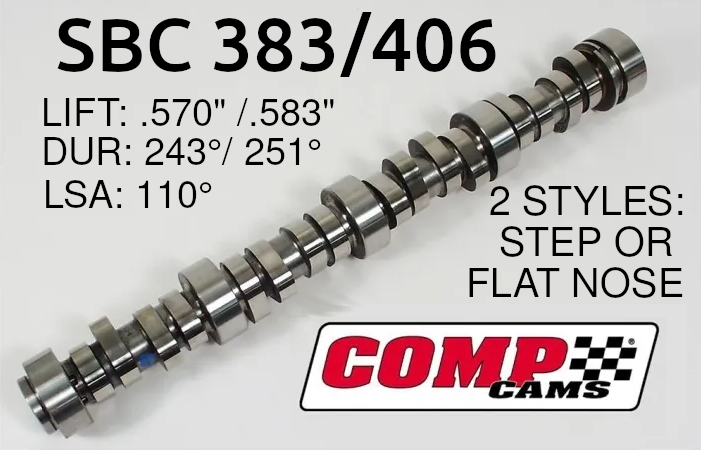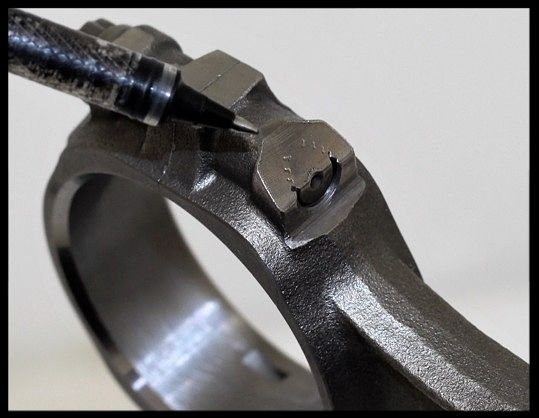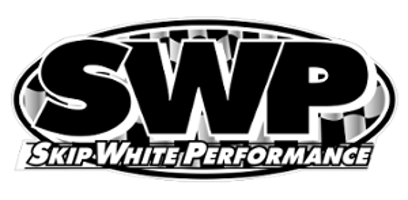
SBC 383/406 Comp Cams - .570"/.583" Lift 243°/251° Duration - OE Hydraulic Roller
$536.95
Available
Variants:
Step Nose [08-00-8-11328]Flat Nose [12-000-8-570]
Comp Cams SBC Xtreme Energy Step Nose Hydraulic Roller Camshafts.
These special cams are made from an Austempered Ductile Iron Core, (a super hardened cast core), and have a reduced base circle (1.050). This allows the use of most rods on the market without having to grind any material from them when used in engines with a 3.750 stroke crank, such as those in the 383 and 406 SBC engines, and this includes the Scat H-beam rods, as they usually have the worst cam to rod interference.
The 421 stroke cranks, (3.875) required very little grinding and, depending on the rod type, you may not have to grind them at all. This not only preserves the integrity of the rod, but most importantly, the rod bolt. By not having to grind the rods, you will also maintain the balance of the rotating assembly, should it have been already balanced before the rods were cam clearanced. We now use these reduced base circle cams in every SBC engine we build.
These special cams can be used with a regular distributor gear. No need to run a bronze gear. Pushrod length will usually be approx. .050 longer than what a full base circle cam uses due to the reduced base of this cam.
Be sure to checkout the "Dyno Results" tab at the top of this description.
About our Custom Grind Cams
Our new line of Comp custom ground street rod cams has improved our horse power and torque numbers better than anything we have done to our lineup of street rod engines. The profiles on these cams are unique. We have increased the hp numbers approx. 20-30 with no increase in lift and duration or lobe separation as compared to our former line of cams. Please see our YouTube channel for many dyno reports with various combinations of intakes and rocker ratios, and showing this cam used in engine sizes from 383 cubic inch all the way up to our 434 pump gas street rod engines. These ads will show you many characteristics of the cam and how it will perform and our recommendations on what to expect as far as street manners are concerned.
We are often asked the rpm operating range of a given cam as stated on the cam card. This info is useless, in our opinion. These rpm ranges can be very misleading. It would be fair to say that 99.9% of people misinterpret these numbers. If we asked 20 different people just what does "operating range" mean, they would all most likely come up with a different explanation. Most people are also not aware that the size of your engine will drastically change the operating range numbers, and if you do understand that, then one must still wonder what operating range actually means.
Many cam cards will also make mention of the cam's uses and characteristics, and we often find that info to be misleading also. The worst place to get cam recommendations is from a friend that has an engine similar to yours. Your friend often has nothing to to compare it against, and therein lies the problem. The next worst place to get a cam recommendation is from the cam manufacturer's tech dept. We have many customers asking us to put a cam in an engine we're building them based on the recommendations from a cam company they have spoken to. We usually find the recommendations to be terribly wrong for the customer's application.
Our experience on a cam's characteristics in a vehicle are based on years of feedback from our customers that have bought engines from us. This is real world experience. Our Superflo Dyno has shown us exactly what a given cam will do in a given size engine. The compression ratio is also a very important factor in what a cam will do in an engine.
Reduced Base Circle (1.050")
 Take a look at what has to be done to the rod body and bolt section of this rod (picture to the right) to clear a full base circle cam in a 3.750 stroke (383 or 406 stroker) engine. The idea of having to go this far into the bolt is unsettling, to say the least. The reduced base circle cam eliminates having to do this. As mentioned above, this is one of the many reasons we now use the reduced base cams in all our SBC engines.
Take a look at what has to be done to the rod body and bolt section of this rod (picture to the right) to clear a full base circle cam in a 3.750 stroke (383 or 406 stroker) engine. The idea of having to go this far into the bolt is unsettling, to say the least. The reduced base circle cam eliminates having to do this. As mentioned above, this is one of the many reasons we now use the reduced base cams in all our SBC engines.
Rod bolt and rod failure can often result in taking away too much material. Reduced Base Circle cams provide these benefits:
-
Increased Rod Clearance : In stroker builds, the longer stroke pushes the connecting rods further down in the cylinder. This can create clearance issues between the camshaft and the rotating assembly (especially the rods). A reduced base circle cam helps avoid this problem by creating more space between the cam lobes and the connecting rods, preventing contact or interference during operation.
-
Retain Larger Stroker Cranks : Since stroker engines use cranks with larger throws, using a reduced base circle cam allows you to keep a larger stroke while still ensuring all moving parts fit properly within the block. This is especially important in SBC engines where block space is at a premium.
-
Avoid Notching the Block : Without a reduced base circle cam, you may need to make significant modifications to the block or grind down parts of the connecting rods for clearance. Using this type of cam reduces or eliminates the need for such modifications, preserving block strength and reducing labor.
-
Maintain Proper Valve Timing : A reduced base circle cam is designed to keep the same valve timing characteristics as a standard cam, even with the smaller base circle. This means you get the clearance benefits without sacrificing the engine’s performance, as it can still achieve proper valve lift and duration.
Avoid Valve Float
When you are running a decent-sized hydraulic roller cam in an engine, valve float can be an issue. We use Howards Max Effort lifters and our COMP Cams lightweight springs . The cost is only slightly more than the regular Howards Street Tie-Bar lifters, and they are undoubtedly the most stable hydraulic roller lifters on the market without going to all out racing hydraulic roller lifters.
The Max Efforts are also very quiet. Not sure what rpm range they can remain stable at, but we have pushed many of our SBC engines up to the 6,650 rpm range in order to establish the fall off point of a particular build. We now use these lifters with many of our cam choices. We have tried the Morel tie bar hyd. roller lifters on cams in the .550" and higher lift range in the past and found them highly unstable at around 5800 rpm.
Well before audible valve float was evident, the horse power numbers were falling sharply due to valve float. Any cam that's approaching the .550" lift or higher range should not use the Morel street/strip lifters. The Max Efforts were very stable well into the 6500 rpm range and higher. The cam in this add is below the 550 lift range but close enough to the limit that we recommend the Max Effort lifters.
Spring Pressure
Another big cause for valve train instability when running a cam in the upper lift and duration in an engine would be having spring pressure that is too low. Regardless of what some may say would be the correct spring pressure, we have came to our own conclusions based on the thousands of engines we've built. We base these on safe operation and good performance. The numbers are slightly high, according to some uninformed authorities, but running too low of a spring pressure will assure valve float before peak power is made.
If you have weak springs or wrong pressure ranges in your setup, then you must correct this. We offer a proper set of Comp valve springs that work perfectly with this cam. They do not require unusually long valves. We're very satisfied with the seat to nose ratio. These springs are also much lighter in weight than previous springs we have used, and that's a real plus when trying to stabilize the valve train on an engine running at near or above 6000 rpm. The countless engines and dyno tests we've performed in-house gives us considerable experience on how to properly setup your valve train.
How big?
You can use our Camshaft Request form to send us the info we need to make a recommendation.
Running a cam that is too big in a given combination is not only pointless for making increased power, but creates a increased loss of drivability and unnecessary wear on the valve train. You must have sufficient cubic inch and/or compression ratio, coupled with correct size cylinder heads that will allow enough flow, to justify a particular size cam.
Bottom-end and mid-range performance are always affected when you increase cam size, but it would be affected even more if a cam selection is over-sized to the point that no top-end power is gained. So choosing too large of a cam becomes a two-fold problem. Tuning also becomes more difficult with larger than needed cams.
Attention Valued Customers!
When it comes to highly technical questions, our sales team at Skip White Performance might not always have the detailed answers you're looking for, especially on topics like installation procedures or tuning.
For those with detailed or specific questions, we strongly recommend checking out automotive forums and communities where these products are frequently discussed. These forums are a treasure trove of information and can provide the expert advice you need. Additionally, YouTube has countless tutorials and guides that walk you through the installation process and other technical details.
Please note: While we're here to provide top-notch products, we cannot be held responsible for any damage resulting from the use or installation of this product. Make sure to do your research and proceed with caution!
Thank you for choosing Skip White Performance!
Disclaimer
Skip White Performance is not liable for any collateral damage or incidental issues arising from the use or misuse of our products. High-performance parts are intended for experienced professionals and enthusiasts. Use at your own risk.Product Information
| Product Type | Camshaft |
|---|---|
| Price (excl. tax) | $536.95 |
| Price (incl. tax) | $536.95 |
| Tax | $0.00 |
| Availability | Available |
| Base Circle (in) | 1.05 |
| Block | SBC |
| Brand | COMP Cams |
| Intake Valve Lift with Factory Rocker (in) | 0.57 |
| Camshaft Style | Hydraulic Roller |
| Shipping Cost | 16.0 |
| Lobe Separation (°) | 110 |
| Exhaust Duration @ .050" Lift (°) | 251 |
| Exhaust Valve Lift with Factory Rocker (in) | 0.583 |
| Intake Duration @ .050" Lift (°) | 243 |
| Number of reviews | 0 |
Customer Reviews
This product does not have any reviews yet.

